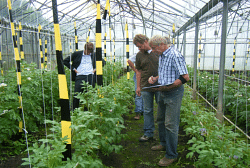Solynta presents breakthrough potato breeding technology
Solynta presents breakthrough potato breeding technology

At the conference of the European Association of Potato Research (EAPR) starting today, the Dutch company Solynta will present their breakthrough in potato breeding.
Pim Lindhout (Solynta) will give a lecture entitled "A new Paradigm in Potato breeding"detailing the achievements of Solynta and highlight the unprecedented consequences for potato breeding, propagation, farming, processing and consumption.
Potato breeding is a slow process. Although many new varieties have been developed, today's potato industry is still dominated by two potato varieties that were developed early last century: Bintje (1904) in Europe and Russet Burbank (1914) in North America.
Genetic improvement in potato is hampered by the fact that potato is a tetraploid (4 sets of chromosomes). Alternatively, severe inbreeding depression and self-incompatibility in diploid germplasm has hitherto blocked the development of inbred lines.
Recently a gen was discovered (Sli) that prevented inbreeding depression in diploid potato lines. However, no good agronomic properties were obtained.
By testing dozens of F2 populations and crosses of selected self-compatible F2 plant with the germplasm core collection, highly inbred lines were developed that combined self-compatibility with a good agronomic performance.
This enables the development of F1 hybrid potato lines, which by most was considered unrealistic so far.
This (non-GMO!) technology offers the perspective of a much faster breeding process and the ability to incorporate newly found traits in a much shorter time.
It also opens up new possibilities for propagation of potatoes using seed instead of tubers.










